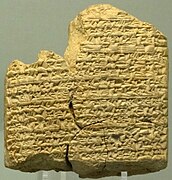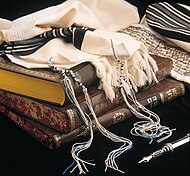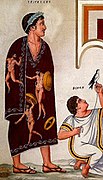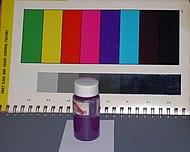Tyrian purple
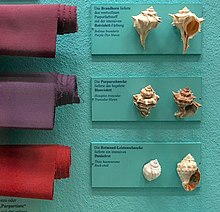
Tyrian purple (
History
Tyrian purple may first have been used by the ancient Phoenicians as early as 1570 BC.[3][4] It has been suggested that the name Phoenicia itself means 'land of purple'.[5][6] The dye was greatly prized in antiquity because the colour did not easily fade, but instead became brighter with weathering and sunlight. It came in various shades, the most prized being that of black-tinted clotted blood.[7][4]
Because it was extremely tedious to make, Tyrian purple was expensive: the 4th century BC historian
By the fourth century AD, sumptuary laws in Rome had been tightened so much that only the
Some[who?] speculate that the dye extracted from the Bolinus brandaris is known as argaman (ארגמן) in Biblical Hebrew. Another dye extracted from a related sea snail, Hexaplex trunculus, produced a blue colour after light exposure which could be the one known as tekhelet (תְּכֵלֶת), used in garments worn for ritual purposes.[11]
Production from sea snails

The dye substance is a mucous secretion from the
In nature, the snails use the secretion as part of their
Many other species worldwide within the family Muricidae, for example
Royal blue
The Phoenicians also made a deep blue-coloured dye, sometimes referred to as royal blue or hyacinth purple, which was made from a closely related species of marine snail.[19]
The Phoenicians established an ancillary production facility on the
This second species of dye murex is found today on the Mediterranean and Atlantic coasts of Europe and Africa (Spain, Portugal, Morocco).[13]
Background

The colour-fast (non-fading) dye was an item of luxury trade, prized by Romans, who used it to colour ceremonial robes. Used as a dye, the colour shifts from blue (peak absorption at 590 nm, which is yellow-orange) to reddish-purple (peak absorption at 520 nm, which is green).[22] It is believed that the intensity of the purple hue improved rather than faded as the dyed cloth aged. Vitruvius mentions the production of Tyrian purple from shellfish.[23] In his History of Animals, Aristotle described the shellfish from which Tyrian purple was obtained and the process of extracting the tissue that produced the dye.[24] Pliny the Elder described the production of Tyrian purple in his Natural History:[25][b]
The most favourable season for taking these [shellfish] is after the rising of the Dog-star, or else before spring; for when they have once discharged their waxy secretion, their juices have no consistency: this, however, is a fact unknown in the dyers' workshops, although it is a point of primary importance. After it is taken, the vein [i.e. hypobranchial gland] is extracted, which we have previously spoken of, to which it is requisite to add salt, a sextarius [about 20 fl. oz.] to every hundred pounds of juice. It is sufficient to leave them to steep for a period of three days, and no more, for the fresher they are, the greater virtue there is in the liquor. It is then set to boil in vessels of tin [or lead], and every hundred amphorae ought to be boiled down to five hundred pounds of dye, by the application of a moderate heat; for which purpose the vessel is placed at the end of a long funnel, which communicates with the furnace; while thus boiling, the liquor is skimmed from time to time, and with it the flesh, which necessarily adheres to the veins. About the tenth day, generally, the whole contents of the cauldron are in a liquefied state, upon which a fleece, from which the grease has been cleansed, is plunged into it by way of making trial; but until such time as the colour is found to satisfy the wishes of those preparing it, the liquor is still kept on the boil. The tint that inclines to red is looked upon as inferior to that which is of a blackish hue. The wool is left to lie in soak for five hours, and then, after carding it, it is thrown in again, until it has fully imbibed the colour.
Archaeological data from Tyre indicate that the snails were collected in large vats and left to decompose. This produced a hideous stench that was actually mentioned by ancient authors. Not much is known about the subsequent steps, and the actual ancient method for mass-producing the two murex dyes has not yet been successfully reconstructed; this special "blackish clotted blood" colour, which was prized above all others, is believed to be achieved by double-dipping the cloth, once in the indigo dye of H. trunculus and once in the purple-red dye of B. brandaris.[7][19]
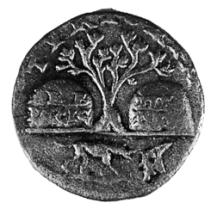
The Roman
Recently, the archaeological discovery of substantial numbers of Murex shells on
The production of Murex purple for the Byzantine court came to an abrupt end with the
In 1909, Harvard anthropologist
In 2021, archaeologists found surviving wool fibers dyed with royal purple in the Timna Valley in Israel. The find, which was dated to c. 1000 BC, constituted the first direct evidence of fabric dyed with the pigment from antiquity.[34]
Murex purple production in North Africa

Murex purple was a very important industry in many Phoenician territories and Carthage was no exception. Traces of this once very lucrative industry are still visible in many Punic sites such as Kerkouane, Zouchis, Djerba and even in Carthage itself. According to Pliny, Meninx (today's Djerba) produced the best purple in Africa which was also ranked second only after Tyre's. It was found also at Essaouira (Morocco). The Royal purple or Imperial purple[35] was probably used until the time of Augustine of Hippo (354–430) and before the demise of the Roman Empire.
Dye chemistry
Variations in colours of "Tyrian purple" from different snails are related to the presence of
In 1998, by means of a lengthy trial and error process, a process for dyeing with Tyrian purple was rediscovered.[37][38] This finding built on reports from the 15th century to the 18th century and explored the biotechnology process behind woad fermentation. It is hypothesized that an alkaline fermenting vat was necessary. An incomplete ancient recipe for Tyrian purple recorded by Pliny the Elder was also consulted. By altering the percentage of sea salt in the dye vat and adding potash, he was able to successfully dye wool a deep purple colour.[39]
Recent research in
Modern hue rendering
True Tyrian purple, like most high-chroma pigments, cannot be accurately rendered on a standard RGB computer monitor. Ancient reports are also not entirely consistent, but these swatches give a rough indication of the likely range in which it appeared:
_________
_________
The lower one is the sRGB colour #990024, intended for viewing on an output device with a gamma of 2.2. It is a representation of RHS colour code 66A,[41] which has been equated to "Tyrian red",[42] a term which is often used as a synonym for Tyrian purple.
Philately
The colour name "Tyrian plum" is popularly given to a
Gallery
-
Painting of a man wearing an all-purple toga picta, from an Etruscan tomb (about 350 BC).
-
Roman men wearing togae praetextae with reddish-purple stripes during a religious procession (1st century BC).
-
The Empress Theodora, the wife of the Emperor Justinian, dressed in Tyrian purple. (6th century).
-
A medieval depiction of the coronation of the Emperor Charlemagne in 800 AD wearing royal blue. The bishops and cardinals wear Tyrian purple, and the Pope wears white.
-
A fragment of the shroud in which the Emperor Charlemagne was buried in 814 AD. It was made of gold and Tyrian purple from Constantinople.
-
6,6'-dibromoindigo, the major component of Tyrian purple
See also
- Bolinus brandaris – Species of gastropod
- Hexaplex trunculus – Species of gastropod
- Indigo dye – Chemical compound, food additive and dye
- Tekhelet – A blue dye mentioned in the Hebrew Bible and prized by ancient Mediterranean civilizations
Explanatory notes
- ^ Because of research by Benkendorff et al. (1999), the Tyrian purple precursor tyrindoleninone is being investigated as a potential antimicrobial agent with uses against multidrug-resistant bacteria.
- S2CID 162937239. See also: C. J. Cooksey (2001) "Tyrian purple: 6,6'-Dibromoindigo and Related Compounds", Molecules, 6 (9) : 736–769, especially page 761. Indigo, which is chemically very similar to Tyrian purple, behaves similarly. See: http://www.indigopage.com/chemistry.htm
References
- ISBN 0-7613-2112-8.
- ^ PMID 33507987.
- ^ McGovern, P. E. and Michel, R. H. "Royal Purple dye: tracing the chemical origins of the industry". Analytical Chemistry 1985, 57, 1514A–1522A
- ^ OCLC 936144129.
- ^ Cunliffe, Barry (2008). Europe between the Oceans: 9000 BC – AD 1000. New Haven, Connecticut: Yale University Press. p. 241.
- ^ "Phoenician". Online Etymology Dictionary.
- ^ a b "Pigments: Causes of Color". WebExhibits.org. Retrieved 10 June 2016.
- ^ Theopompus, cited by Athenaeus (12:526) around 200 BC.Athenaeus (1941). The Deipnosophists. Translated by Gulick, Charles Barton. Cambridge, Massachusetts: Harvard University Press.
- ^ Jacoby D (1997). "Silk in Western Byzantium before the Fourth Crusade". Trade, Commodities, and Shipping in the Medieval Mediterranean. pp. 455 ff and notes [17]–[19].
- ISBN 0-195-04652-8.
- ^ Elsner O (1992). "Solution of the enigmas of dyeing with Tyrian purple and the Biblical tekhelet". Dyes in History and Archaeology. 10. pages 14 ff.
- .
- ^ a b Radwin, G. E.; D'Attilio, A. (1986). Murex shells of the world. An illustrated guide to the Muricidae. Stanford, CA: Stanford University Press. p. 93. 284 pp incl 192 figs. & 32 pls.
- ^ Benkendorff K (March 1999). Bioactive molluscan resources and their conservation: Biological and chemical studies on the egg masses of marine molluscs (Thesis). University of Wollongong. Archived from the original (PDF) on 30 August 2007. Retrieved 25 February 2008.
- JSTOR 3591386.
- ^ Gould AA (1853). "Descriptions of shells from the Gulf of California and the Pacific coasts of Mexico and California". Boston Journal of Natural History. 6: 374–408. ; see pp. 406–407. Note: Gould called this species Purpura pansa ; it was later renamed Plicopurpura pansa.
- ^ Plicopurpura patula was originally named Buccinum patulum by Linnaeus in 1758:
- von Linné C (1758). Systema naturæ per regna tria naturæ … (in Latin). Vol. 1. Stockholm, Sweden: Lars Salvius. p. 739.
- World Register of Marine Species (Web site): Plicopurpura patula (Linnaeus, 1758).
- Cossmann M (1903). Essais de paléoconchologie comparée (in French). Vol. 5. Paris, France: (Self-published). pp. 68–69.
- ^ Biggam CP (March 2006). "Whelks and purple dye in Anglo-Saxon England" (PDF). The Archaeo+Malacology Group Newsletter (9). Glasgow, Scotland, UK: Department of English Language, University of Glasgow. Archived from the original (PDF) on 2011-02-19. Retrieved 2009-11-19.
- ^ ISBN 1-57506-042-6.
- ^ Hogan CM (2 November 2007). Burnham A (ed.). "Mogador: Promontory Fort". The Megalithic Portal.
- ^ In 1758, Linnaeus classified the snail as Murex trunculus:
- von Linné C (1758). Systema naturae per regna tria naturae … (in Latin). Vol. v.1. Stockholm, Sweden: Lars Salvius. p. 747.
- Perry G (1810–1811). Arcana, or, The museum of natural history ... London, England: James Stratford. p. Plate XXIII: Genus: Triplex.
- Mathews GM, Iredale T (May 1912). ""Perry's Arcanda" – an overlooked work". The Victorian Naturalist. 29 (1): 7–16. ; see p. 11.
- World Register of Marine Species (Web site): Hexaplex Perry, 1810
- PMC 6236399.
- ^ Vitruvius. De Architectura [On Architecture]. Book VII, Chapter 13.
- ISBN 9781419123917.
- ^ Pliny the Elder (1855). "Chapter 62: The Natural History of Fishes". In Bostock J, Riley HT (eds.). The Natural History. London, UK: Taylor and Francis. Book IX. Pliny discusses Tyrian purple throughout Chapters 60–65.
- ^ John Malalas, Chronographia II:9.
- ^ Reese, David S. (1987). "Palaikastro Shells and Bronze Age Purple-Dye Production in the Mediterranean Basin", Annual of the British School of Archaeology at Athens, 82, 201–206
- ^ Stieglitz, Robert R. (1994), "The Minoan Origin of Tyrian Purple", Biblical Archaeologist, 57, 46–54.
- ISBN 9788882650155.
- ^ Jacoby (2004), p. 210.
- ^ Nutall Z (1909). "A curious survival in Mexico of the use of the Purpura shell-fish for dyeing". In Boas F (ed.). Anthropological Essays Presented to Fredrick Ward Putnam in Honor of his Seventieth Birthday, by his Friends and Associates. New York, New York: G. E. Strechert & Co. p. 370.
- ^ Robinson S (1969). A History of Dyed Textiles. London, UK: Studio Vista. p. 24.
- ISBN 9781439276839.
- PMID 33507987.
- ^ "Definition of the Tyrian purple". World History Encyclopedia. Archived from the original on 24 July 2016.
- .
- OCLC 45315310.
- ^ "Author Profile". Imperial-Purple.com. Archived from the original on 13 July 2011. Retrieved 13 July 2011.
- ^ Chenciner, Robert (2000). Madder Red: A history of luxury and trade: plant dyes and pigments in world commerce and art. Richmond: Curzon Press. p. 295.
- .
- ^ "RHS, UCL and RGB Colors, gamma = 1.4, fan 2". Azalea Society of America. Archived from the original on 11 March 2007. Retrieved 15 July 2006. (this gives the RGB value #b80049, which has been converted to #990024 for the sRGB gamma of 2.2)
- ^ Buck, G. "Buck Rose". p. 5. Archived from the original on 23 August 2006.
- ^ "Edward VII 2d". Postal Museum. Collection catalog.
External links
- "Tyrian Purple". World History Encyclopedia.
- Cooksey CJ (1994). "Making Tyrian purple". Dyes in History and Archaeology. 13: 7–13 (email the author for a copy). Archived from the original on 2020-07-26. Retrieved 2010-05-11.
Source of article in author's Bibliography page.
- Guckelsberger M (December 2013). Purple Murex Dye in Antiquity (PDF) (Thesis). University of Iceland.
- "Tyrian purple". The Free Library.
- "Royal Purple of Tyre" (PDF).

